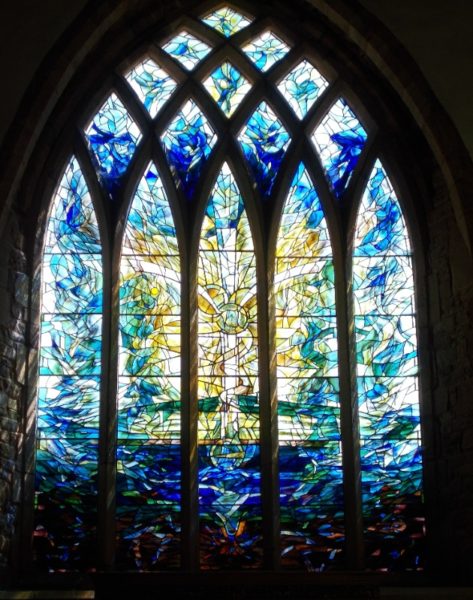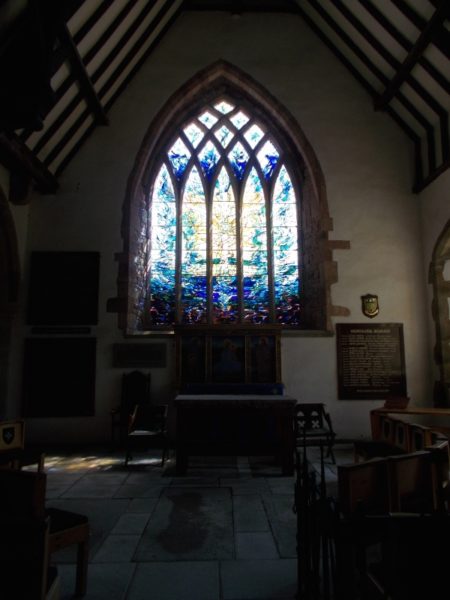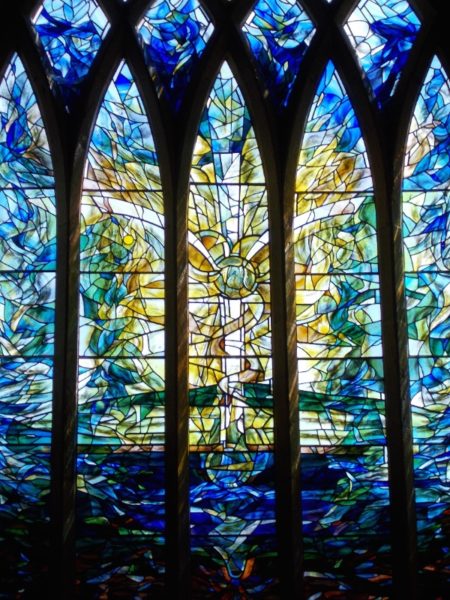Restoration of All Saints Newland continued throughout the 1980s and 90s. The roof was made tight, floors were made safe and those abandoned memorial slabs were dignified with relocation. The organ had also been restored and moved and the addition of new flexible seating allowed the central part of the church to be used for exhibitions and concerts. (When David retired The Royal Forest of Dean orchestra and Monmouth Choral Society put on a farewell concert which included the 1812 Overture, complete with the church’s own bells and canon fire – all I’m assured done with the utmost concern for maximum safety – both human and architectural!)

Henry Haig stained glass window in All Saints, Newland, Gloucestershire
Towards the end of the 1990s, David had a meeting with a local family in the church. The husband and father had recently died and mother, son and daughter wished to give something to the church to commemorate him. On being questioned what the church needed and mindful of not wanting to be greedy, David hesitated and was just about to start running through the list of things he knew people liked to give, when Kathleen, the daughter interrupted him with, “Come on, David, what does the church really need?” As it happened they were standing in the St John and St Nicholas Chapel and, bathed in the cold light of a murky and not very pleasant day, David looked up and flung his arm towards the window, saying, “Well, of course, there’s this window!” “Yes, let’s do it,” the daughter said. David, somewhat winded by the reply pointed out that they were talking rather a lot of thousands of pounds which put the family off not an iota and then and there they determined that would suit them very well, with David agreeing it would suit the church very well too.

Henry Haig stained glass window in All Saints, Newland, Gloucestershire
How to do it? With David having experience of the arcane workings of both Church of England and arts administration, he wanted to avoid the church being pushed towards the usual suspects, at least one of whom expected to be first in line for commissions such as this. An open competition advertised nationally in relevant publications seemed the best approach as long as David could form a small team of interested and experienced people who would be willing to examine and evaluate entries – no small commitment. (Last night we caught a programme on the building of the new Coventry Cathedral which reminded us that its design had been awarded in this way.) To their surprise and delight there were about 150 entries, which were then whittled down to four. These four were then invited to prepare more detailed drawings for exhibition in the church where parishioners and local people could come, view them, question the artists and then express their preferences. (One of the four chosen was Simon Whistler, son of Laurence, who like his father produced engraved glass of a unique quality. He came very close. He died in 2005 with the fear that the art he and his father recreated and perfected might die with them as there was no full time course in glass engraving in the country.)

Henry Haig stained glass window in All Saints, Newland, Gloucestershire
The winner was Henry Haig who had come to stained glass after training as painter and sculptor. One of his best well-known commissions was that for Clifton Cathedral in Bristol (1965-1973) where he used the experimental technique called dalle de verre in which chunks of thick, textured glass are set in epoxy resin to create very large abstract panels in a contemporary setting (the building dates from 1973). At the other end of the scale, and very like Newland’s in size, shape and effect, comes the Yvonne Fletcher window in St Leonard’s Church, in Semley, in Wiltshire. (Yvonne Fletcher was killed while on duty during the Libyan Embassy Siege of 1984; the window was dedicated in 1988.) David remembers that on at least one occasion Kathleen and possibly her brother too, visited Henry in his workshop (a converted racquets court) in the Dorset village of Fifehead Magdalen where she was allowed to have a go at stained glass making herself.
Newland’s widow was commissioned by Joan Ludlum in thanksgiving for the life of her husband Henry who had died in 1991. On the day it was to be dedicated, Joan herself died. Their son Edward and daughter Kathleen then expressed the desire that the window should be dedicated to both their parents and this was done on 14 May 2000 by the Bishop of Gloucester.
Do look at the Thomas Becket window of the Church of St Thomas of Canterbury, Greatford in Lincolnshire, mentioned in a comment below. It was made in 2015 by Helen Whittaker of Barley Studio. The black birds are choughs for which bird the heraldic term is a becket. Also note the little sprig of watercress at the bottom of the window which records the fact that the area used to be known for growing watercress. Lovely to read such details pictorially.

9 Comments
That is a really lovely window, and an aid to contemplation, I think.
Thank you, Rachel. It’s effect is very contemplative and a very good colour balance to the blue altar frontal of the Lady Chapel over on the other side of the high altar.
How lovely to see another of Henry’s windows.
Henry and his wife Joan were good friends of ours and my husband would occasionally give Henry a helping hand with his work.
Extraordinary, Jane. How lovely to hear of your friendship with Henry. Thank you for this – I love to hear about theses serendipity connections.
Your postings on the lovely work in this church brought back memories of the wonderful gift our church received. Thanks to a very generous gift, we were able to commission a window in memory of Thomas Becket, to whom our church is dedicated. The window was designed by Helen Whittaker of the Barley Studio. We didn’t want a representation of the St Thomas himself, but Helen was influenced by the Limoges enamel reliquary casket in the V&A and the design of Becket’s cope to create a journey from earth to heaven. It’s outstanding and I’d be happy to send you a photo. Elizabeth A
It’s always heartening to hear when gifts given and gifts received are so well matched as to give pleasure all round – and left such happy memories too. I’d love to see a picture of the window. Many thanks for emailing.
I’ve just done a search for Helen Whittaker – there’s a very powerful design for a stunning window in the Church of St Thomas of Canterbury, Greatford in Lincolnshire – is that you?
Yes, it is. Helen’s research produced all sorts of quirky facts, for instance in heraldry a becket was a colloquial word for choughs, the (non Lincolnshire) birds which appear. The village used to be a centre for watercress growing, which appears at the bottom of the window. The design exceeded all our expectations, and the most beautiful reflections appear on the opposite wall at certain times of the year.
It’s a stunning window made even more fascinating by all the details incorporated from Helen’s research. It’s just wonderful to think future generations will look at it and ask why those birds and what’s the relevance of the watercress … and find the answers. Thanks for telling me about it.
Hi Mary, thank you for this invaluable information about how the majestic Ludlam window came about. I first visited All Saints on Wednesday and was so blown away by its vibrance and imaginitivity that I brought my wife back to see it today. When I first stepped into the church I immediatley noticed the original window to my left and then turned my head to the right, and wow what an impact this window made on my religious imagination! Within its warm harmonious colours I could see the cross, and then at the foot of the cross the wooden boughs of a boat, and beneath that, the rich colours of the water, and finally the subtle brown hues of the river bed. I could see Jesus walking on the water, or calming the storm, or the miraculous catch of fish. All in my minds eye I know, but that is the beauty of great art, people can get what they want from it.
I have searched the internet but I cannot find any information on what Henry Haig intended, if indeed anything at all, other than making a great symbiotic window. Do you happen to know of any thoughts he had on the window? Best Fred